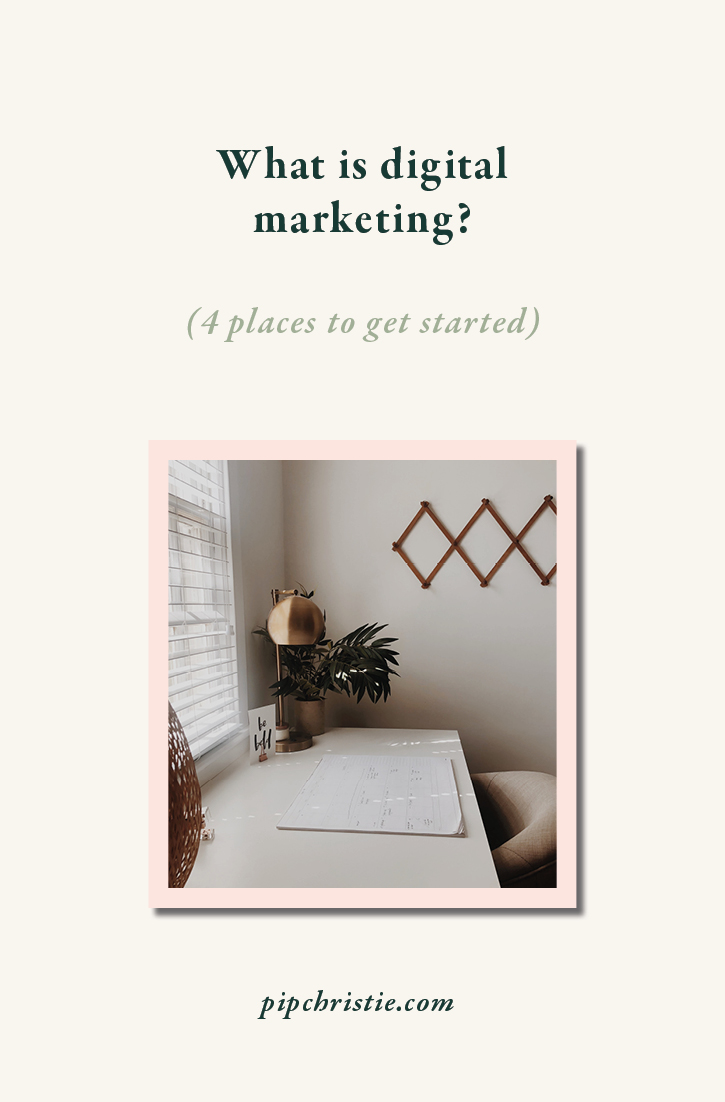What is digital marketing?
Digital marketing seems to be something of a hot topic these days. We’re all hearing constant chatter of the focus being on all things digital, the growth of social media (and, admittedly, its potential impact on our health) seems to be splattered across the news every single day.
We’re told that we need to focus on digital marketing for our small businesses to shine, but what does that really mean?

What even is digital marketing?
It’s a great question and one that you shouldn’t feel too shy to ask! Even when I worked in-house running digital marketing and communications it was clear to me that not everyone in the organisation understood what I really did. I’d often be introduced as, “this is Pip, she runs our social media” but in reality digital marketing is so much more than that.
Let’s take a walk through some of my top components of a good approach to digital marketing.
Your Website
I’ve put your website first here for a reason. Statistics show, quite alarmingly, that 40% of small businesses do not have a website. Your website is essentially your online storefront. This is the first major interaction that your audience will have with your business in a space that is entirely owned by you. By that I mean, you’re not beholden to the whims of Instagram or Twitter in affecting how your brand appears.
This is your space and you are fully in control of how it appears and the experience that your visitors have. Of course, this brings great opportunity but it can also be rather daunting – there’s no blaming any algorithm for visitors not connecting with your brand! Your website could consist of information about your services, your products or perhaps your menu alongside value adding content such as a blog, resources and testimonials.
You want your visitors to have an easy experience on your website. From the first click, your brand’s story needs to be visible and connecting. There should be a seamless journey that you gently encourage your website visitors to follow, taking them from cursory introductions through to making that all important purchase or booking. Trust me when I say that this is one of the most fun parts of digital marketing, it just might take a bit of practice to get it right first!
Social Media
I’m sure you all knew that I was going to say that one, right? We live in the world where social media is a full time job and entire careers can be made, or broken, inside one tiny app.
The beauty of social media is that you’re hanging out where your target customers are spending their leisure time. Done well, a good approach to social media marketing means that you can sit alongside your customers’ mates and celebrity idols, and fit in with those conversations.
Social media isn’t a place to be overtly salesy with your digital marketing, it’s a space to build your brand awareness and connect with your audience on a more personal level. You are, after all, joining them in front of the TV on a Thursday night or keeping them company on their early commute into work. It’s important to respect that.
A word of caution here. I’m a firm believer that for an organisation to be successful at digital marketing, they need to have a strong presence across all the platforms where they can find their ideal audience. There’s no point putting a lot of effort into Facebook if all your target customers are on Instagram. Just like there’s going to be little return running a social media ad campaign to direct people to your clunky old website.
Digital Advertising
Potentially a lesser known ingredient to a cohesive approach to digital marketing is digital advertising. What do I mean by that?
Digital advertising can encompass a number of different things, from social media ads to Google AdWords to Google Display Ads. These are your chance to remind your new connections of who you are and how you can help them.
The key here is to remember to add value. Let’s say Jo from Manchester has started following your Facebook page. You wouldn’t just want to pop up in her Facebook page inviting her to spend a couple of hundred pounds on your product right away would you? I’m pretty sure Jo would find that a bit spammy.
Instead, consider how you can deepen your connection with Jo and help her see how you are a go to resource for her field of expertise. Perhaps it’s offering her a free ebook to solve a problem she’s been having, or maybe you’d like to invite her to a webinar you’re hosting next week. Either way, it’s important to remember that if you want to build a long term relationship with Jo (and no, this isn’t a dating site) you’re going to need to take the softly softly approach.
Email Marketing
This brings me nicely over to email lists. I’m sure you’ve heard that email lists are important for your business but how can we put that into practice?
Email lists form an integral part of your digital marketing approach primarily because they are data that you possess, in your own hands, about your audience. It’s all very well focussing on growing your social media following – don’t get me wrong, that’s incredibly important – but you don’t ‘own’ that data. That belongs to Facebook, Twitter or whichever platform you’re using. And if they decide to restructure their business, close down or experience a major glitch, you could very well loose those connections.
By connecting with your followers, just like Jo from Manchester, and developing those deeper relationships you’re also gaining more knowledge about them, including their email addresses that they entered to receive your free download or book onto that webinar. And now you need to show up for them in return.
Whether it’s a monthly newsletter, a weekly update or something else, email marketing allows you to nurture your lead through to making a more serious commitment with you i.e. to spend money.
Just remember, this isn’t the time to go from zero to hero. Respect your subscribers’ inboxes and be mindful as to how you show up for them.
What’s the common thread?
You may have noticed by now that these components all have one common thread tying them together. And that’s your story.
It’s so important to avoid seeing any aspect of digital marketing in isolation. Instead, view it as a multi-faceted approach to telling the story of your business. To build a cohesive approach to digital marketing you need to have your story straight:
- Who are you?
- What’s your mission?
- Why do you show up every day?
- How do you add value?
- What makes you unique?
To show up authentically for your audience, you need to know who you are, how you speak and why you are here. That’s what will make your brand instantly recognisable and, better than that, memorable.
And, remember, you want to add value to your customers. It’s very rare that someone will jump from free to paid in the small business sector. Instead, consider how you can nurture those long term relationships that will last for years to come.
Write your website copy like a pro copywriter (without the pro price tag)
Introducing... the about page roadmap.
You’ll get access to the same copywriting framework I use with my small business clients. So you can have an about page that feels 100% you.



